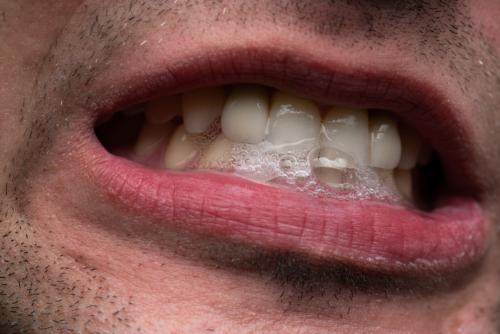My baby has allergies, what am I doing?

Allergy problems appear to exist only in certain families, leading to the conclusion that there may be some genetic predisposition for allergic diseases. If parents suffer from a certain allergy, there are chances that children become allergic because they come in contact with the various substances in their environment. Allergens are, in most cases, some trivial things with which children come in contact with the skin that protects their body, the air they breathe, the food they consume, and the medicines they are administered on various occasions . Their evolution, almost simbiotic, has as a starting point, from very young age, an atopic dermatitis, in the conditions in which it can rapidly join food allergies, because afterwards, as the baby grows, the main entities of the march . The first allergic condition, which is also the most common chronic skin disease in childhood, is atopic dermatitis. Early signs of illness may appear from the first few weeks, but generally occur from the third month of life of babies.
In response to the dryness of the skin, they will start to scratch and develop rapidly a reddish rash at the cheeks, throat, trunk, rounded areas of the hands and feet, in the elbow and knee area. Because itching will be irritated, agitated, will cry much and have serious sleep problems. Many of them will have more colic, they may shed or may have diarrhea, mucus, and even blood stools that are related to the various food allergies they can develop along the way. Often, those areas where the skin is intensely scratched are over-infected and covered with crusts, and they get a yellowish look, Diagnosis of atopic dermatitis is symptomatic and focuses only on the itching of the skin, on its dryness. It does not require very many allergic investigations unless it occurs in a severe clinical form.
Skin allergic tests or serological determinations will be geared to the clinical history of the child, adapted to their age, and will be strictly related to their manifestations. You also have to take into account the fact that the little one has great chances to enter the mood of atopy, which will expose him during his lifetime and to various other challenges, starting with food allergies and continuing with allergic rhinitis or allergic asthma . There are good news too. Allergic skin inflammation from the first months of life tends to self-diminish somewhere around the age of 2 or 3 years, unlike those forms of dermatitis that occur later and can persist in adulthood. The exception, however, is only certain forms of food allergies, especially milk, egg or gluten, which disappear as the baby grows and develops tolerance towards those foods, Although the cause of atopic dermatitis is genetic, linked to the poor quality of the skin's superficial layer, it can be triggered and maintained by contact with various other factors such as house dust, pollens, molds or pet hair that are allergenic .
You should keep in mind that one out of three children with severe atopic dermatitis may develop food allergies and over half of them may later have rhinitis or allergic asthma. In addition to these, you can come through the acute stages of the disease and with various medications such as corticosteroids or immunomodulators, which are usually administered locally and are absolutely necessary when inflammation of the skin can no longer be controlled by softening, Although the treatment plan will observe some mandatory principles, it will always be personalized. Allergies that may require special prevention and treatment measures, as well as possible microbial or viral infections that may complicate their development, will be considered. You will start fighting atopic dermatitis with the idea that it does not play honestly, does not follow the rules, has no logical evolution and that those remedies that have worked perfectly for a while may become ineffective for controlling the disease. Food allergies, the second largest category of children's allergic diseases, arise when their immune system starts to reject various food proteins, considering them dangerous.
This is not the case when babies have a food intolerance. The latter can make them feel bad because they can not digest a whole food, but do not put their lives at risk, as a severe food allergy can do. However, there is a fairly large statistical difference between allergies that are declared by the parents and those that will later be confirmed by allergic investigations. The most accurate diagnosis can be made both for determinations of specific IgE specific antibodies to allergens or certain molecular components derived from allergenic sources, ie serological and molecular allergy testing, but also for classical skin tests and in particular for challenge tests . There are over 170 foods that can trigger food allergies.
Of these, in Europe, only 14 categories of food are considered dangerous: Grains containing wheat, rye, barley, oats, hybrids Milk Peanut Walnuts (almonds, nuts, nuts, cashews, pecan nuts, Brazil nuts, nuts . When a child develops a food allergy, contact with that allergen can trigger a variety of symptoms. Some appear from the digestive system as: vomiting diarrhea chairs, mucus or even blood chronic constipation abdominal cramps, others are cutaneous manifestations with urticaria or dermatitis edema in various areas of the body but may sometimes have a localized . respiratory manifestations that start from repeated sneezing with abnormal nasal secretions or persistence of the nose in the nose, eyes, and tears, to dry cough, wheezing, and difficulty breathing. The needs of children diagnosed with allergy The first step someone has to do that is allergic is not to eat that food! .
It also matters the thermal preparation of foods, because some enhance their allergenicity after exposure to heat. All these details are very valuable for a family with a child with food allergies, but also for all who care for his care. An allergic reaction can also occur after an accidental allergenic contact, when the allergen is accidentally passed from one food to another. To avoid such situations, strict rules must be followed by parents and children, relatives, friends, educators, sports coaches, chefs or bones. You will also know and follow the action plan in case of anaphylactic shock.
You will set up an Emergency Response Network that will include various categories of people who will be trained to strictly follow the prevention and treatment rules, will know the anaphylaxis action plan and will call for qualified help at the earliest . Allergic children have real needs and need not be excluded, but they must be helped and perfectly integrated into curricular, extracurricular, sporting or entertainment programs. Urticaria Another form of manifestation of allergies is hives or that rash that appears on the baby's skin as if it had been spotted or was mosquitoed. Often, its appearance is self-contained or accompanied by swelling or various swelling, most commonly localized in the face, lips, tongue and, in very serious cases, it may also occur in swollen edema, which is an emergency . Otherwise, urticaria accompanies other signs and symptoms, whether they are digestive or respiratory, cardiovascular, or neurological, which may also occur in various combinations, often constituting the most severe form of allergy manifestation, ie anaphylaxis or shock .
Causes that may trigger a urticarial eruption are either food allergies or drugs or insect stings, but others that are not directly related to allergic reactions such as infections or parasites. Consequently, the necessary investigations can sometimes cover the entire sphere of trigger factors. The picture of a child's urticarial eruption can be a trivial one when the eruption is self-limiting, even without treatment, but sometimes it can be extremely serious, may require a great deal of medication and require hospitalization of the baby. Rhinitis The fourth category of children's allergic diseases are rhinitis. They represent a very well-represented segment of allergies at slightly older ages, but they are also relatively common in small children.
Repeated snails, their allergic Besides the extremely suggestive history, allergic tests that confirm the allergic sensitization of babies are especially necessary, especially as they can be so useful in setting up specific desensitization treatments, the only ones that can influence long-term . When we talk about allergic rhinitis and their complications, we also need to consider allergic asthma. If you have a baby who coughs very often, he wakes up from sleep and can not breathe, he often has a wheezing breath, running, laughing or crying, you have to check through a specialized medical consultation if he does not have such a problem. In addition to allergic tests that may be helpful in avoiding contact with respiratory allergens that trigger the baby's symptoms, respiratory function tests, spirometry or determinations of bronchial inflammation markers in expired air may be performed according to age . Asthma treatment is, in most cases, an inhaler.
As with atopic dermatitis, we also talk about allergic asthma about a whimsical illness that can have very good periods of total control so that suddenly exacerbation. That is why you need to know the action plan very well and to intervene promptly using the two categories of drugs very correctly Also, the allergic child may raise special care problems during kindergarten or during sports activities. Children with allergic asthma should be encouraged to go hiking, do sports and even participate in various competitions. Although they require special attention, they must not be marginalized, but on the contrary they help to integrate in the community! . He must also explain to other children the possible emergency situations that may occur, so as to recognize them and advertise them in a timely manner to help the colleagues who have allergic problems.
.
Source : csid.ro
Views : 3210
Popular Article
- (photo) Nude becomes art.
Posted: 2018-03-17, 9584 views.
- The harmful effects of air conditioning on the skin
Posted: 2017-06-08, 8266 views.
- 3 causes of dyed hair discoloration
Posted: 2017-06-15, 8140 views.
- Why early puberty occurs in girls: symptoms, favors, diagnosis and treatment
Posted: 2017-10-24, 7996 views.
- Good or bad skin treatments in the hot season
Posted: 2017-06-07, 7734 views.
Recommendations
- (photo) Nude becomes art.
Posted: 2018-03-17, 9584 views.
- The harmful effects of air conditioning on the skin
Posted: 2017-06-08, 8266 views.
- 3 causes of dyed hair discoloration
Posted: 2017-06-15, 8140 views.
- Good or bad skin treatments in the hot season
Posted: 2017-06-07, 7734 views.
- Risks of practicing sports on hot days
Posted: 2017-06-12, 7328 views.
 4 effective ingredients in the fight against acne.
4 effective ingredients in the fight against acne. How to get rid of hiccups fast
How to get rid of hiccups fast The wheat bran diet: the secret of lost pounds as if by magic
The wheat bran diet: the secret of lost pounds as if by magic The recipe that will sweeten your soul this weekend!
The recipe that will sweeten your soul this weekend!  Is it dangerous or not to refreeze meat after thawing it?
Is it dangerous or not to refreeze meat after thawing it?  The unusual sign of diabetes indicated by saliva.
The unusual sign of diabetes indicated by saliva. What to drink to boost your immune system.
What to drink to boost your immune system. 10 foods that help you never age.
10 foods that help you never age. What actually happens in your body if you drink a cup of coffee for breakfast
What actually happens in your body if you drink a cup of coffee for breakfast 5 surprising benefits of chia seeds
5 surprising benefits of chia seeds